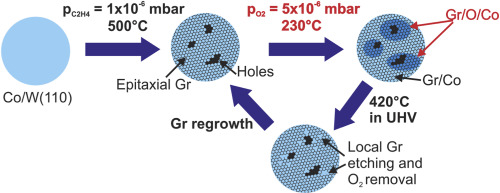Our official English website, www.x-mol.net, welcomes your
feedback! (Note: you will need to create a separate account there.)
Tunable coupling by means of oxygen intercalation and removal at the strongly interacting graphene/cobalt interface
Carbon ( IF 10.5 ) Pub Date : 2020-08-01 , DOI: 10.1016/j.carbon.2020.03.034 Matteo Jugovac , Francesca Genuzio , Tevfik Onur Menteş , Andrea Locatelli , Giovanni Zamborlini , Vitaliy Feyer , Claus Michael Schneider
Carbon ( IF 10.5 ) Pub Date : 2020-08-01 , DOI: 10.1016/j.carbon.2020.03.034 Matteo Jugovac , Francesca Genuzio , Tevfik Onur Menteş , Andrea Locatelli , Giovanni Zamborlini , Vitaliy Feyer , Claus Michael Schneider

|
Abstract It is well known that intercalated species can strongly affect the graphene-substrate interaction. As repeatedly shown by experiment and theory, the intercalation of atomic species may establish a free-standing character in chemisorbed graphene systems. Here, we focus on graphene grown on a strongly interacting support, cobalt, and demonstrate that the film electronic structure and doping can be tuned via the intercalation/removal of interfacial oxygen. Importantly, cathode lens microscopy reveals the main mechanism of oxygen intercalation, and in particular how microscopic openings in the mesh enable oxygen accumulation at the graphene-cobalt interface. Our experiments show that this process can be carefully controlled through temperature, without affecting the film morphology and crystalline quality. The presence of oxygen at the interface induces an upward shift of the graphene π band, moving its crossing above the Fermi level, accompanied by an increased Fermi velocity and reduced momentum width. Control on the graphene coupling to cobalt may enable one to alter the induced spin polarization in graphene’s electronic states.
中文翻译:

在强相互作用的石墨烯/钴界面通过氧嵌入和去除的可调谐耦合
摘要 众所周知,插层物质会强烈影响石墨烯-基材的相互作用。正如实验和理论反复表明的那样,原子种类的嵌入可能会在化学吸附石墨烯系统中建立独立的特征。在这里,我们专注于在强相互作用载体钴上生长的石墨烯,并证明可以通过界面氧的嵌入/去除来调整薄膜电子结构和掺杂。重要的是,阴极透镜显微镜揭示了氧嵌入的主要机制,特别是网格中的微观开口如何使氧在石墨烯-钴界面处积聚。我们的实验表明,该过程可以通过温度小心控制,而不会影响薄膜形态和结晶质量。界面处氧的存在导致石墨烯 π 带向上移动,将其交叉移动到费米能级以上,同时费米速度增加和动量宽度减小。控制石墨烯与钴的耦合可能使人们能够改变石墨烯电子态中的诱导自旋极化。
更新日期:2020-08-01
中文翻译:

在强相互作用的石墨烯/钴界面通过氧嵌入和去除的可调谐耦合
摘要 众所周知,插层物质会强烈影响石墨烯-基材的相互作用。正如实验和理论反复表明的那样,原子种类的嵌入可能会在化学吸附石墨烯系统中建立独立的特征。在这里,我们专注于在强相互作用载体钴上生长的石墨烯,并证明可以通过界面氧的嵌入/去除来调整薄膜电子结构和掺杂。重要的是,阴极透镜显微镜揭示了氧嵌入的主要机制,特别是网格中的微观开口如何使氧在石墨烯-钴界面处积聚。我们的实验表明,该过程可以通过温度小心控制,而不会影响薄膜形态和结晶质量。界面处氧的存在导致石墨烯 π 带向上移动,将其交叉移动到费米能级以上,同时费米速度增加和动量宽度减小。控制石墨烯与钴的耦合可能使人们能够改变石墨烯电子态中的诱导自旋极化。









































 京公网安备 11010802027423号
京公网安备 11010802027423号